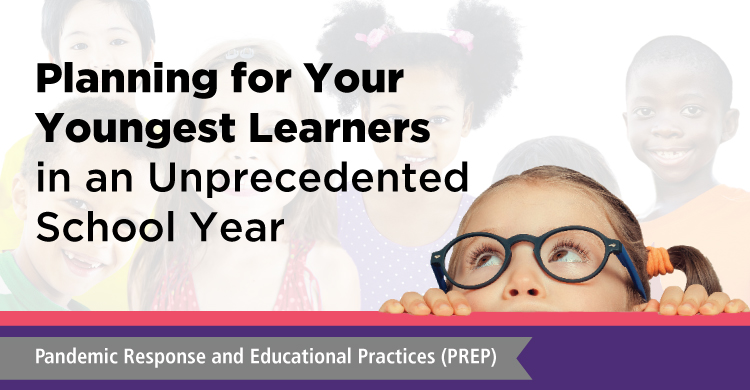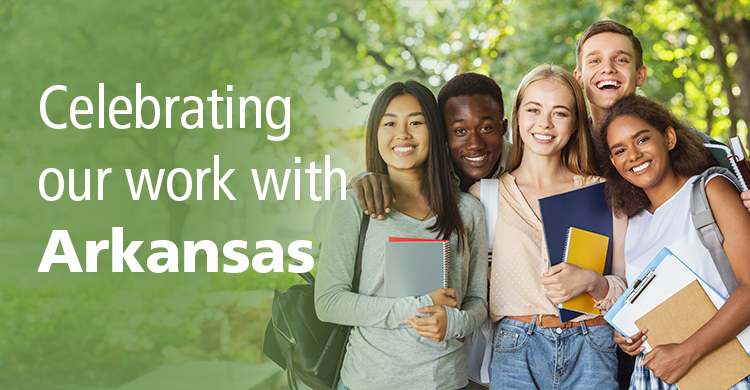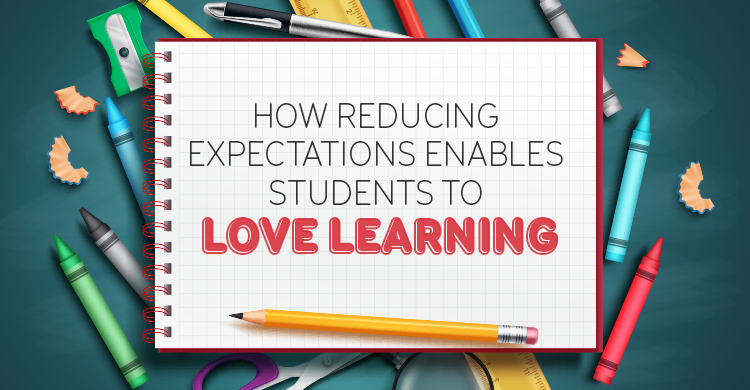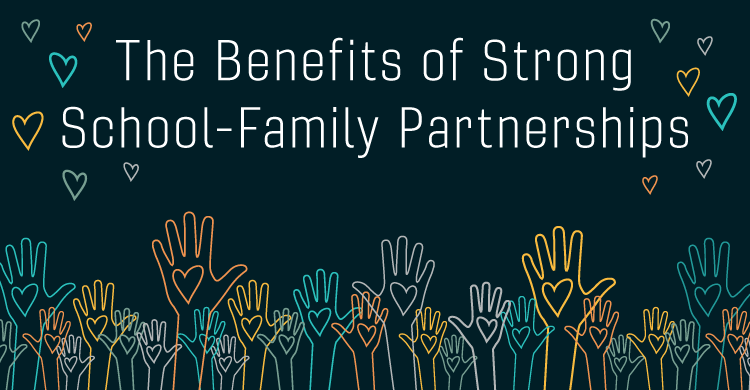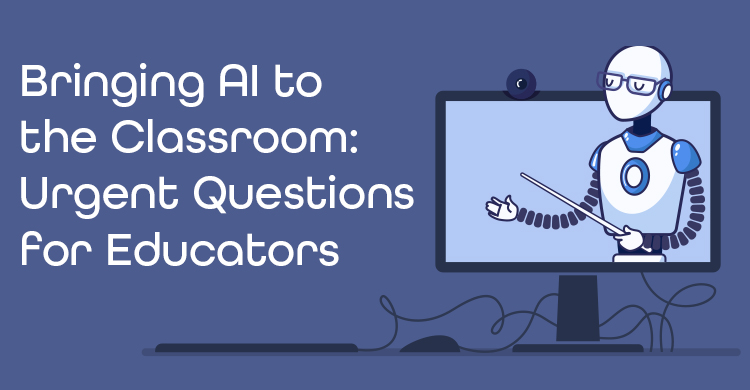This entry is the 12th in a blog series called Pandemic Response and Educational Practices (PREP), which aims to highlight and further the important work educators are doing amid the worldwide COVID-19 crisis.
Based on What About Us? The PLC at Work® Process for Grades PreK-2 Teams
Several years ago, Becky DuFour, expressing her passion for our youngest learners, helped us launch an idea that is now being released as our new book, What About Us? The PLC at Work Process for Grades PreK-2 Teams.
We four coauthors, from Mason Crest Elementary—the first DuFour Award–winning national Model PLC school—filled the book with resources, tools, action steps, and examples for early childhood educators striving to meet the needs of all students. With the publication of the book this month, coinciding with the launch of a school year full of uncertainty, we thought a sneak peek into a few chapters, while considering ideas for adapting to a remote learning environment, could add some welcome tools to early educators’ toolkits.
The legacy that Rick and Becky DuFour left behind is a cadre of educators who embrace the PLC at Work process in order to achieve learning for all, and there is no asterisk by “all” that gives an exception during a pandemic while pivoting between in person and remote environments.
As we embark on a new school year with much unpredictability and so many moving parts, the two things that remain constant and important are a culture of collaboration and grounding all our team work in the four critical questions of learning:
- What do we want our students to learn?
- How do we know students have learned?
- How will we respond when some students have not learned it?
- How will we respond when some students have already learned it?
IF students learn for the duration of this pandemic is not an option—rather it is a question of HOW will we do it. As educators and professionals, we make the choice to take a team approach and have a growth mindset to do this unprecedented work with intention, strength, and love.
In doing so, we need to think about how learning happens for our youngest students. Early childhood educators must keep the whole child in mind when determining what they want students to know and be able to do. The figure below from chapter 2 in What About Us? shows key components of early childhood curriculum, including specific considerations for learning domains, environment, experiences, and assessment. Before your teams begin engaging in this process, use the chart to take a big-picture look at your curriculum and ask:
- Did your pre-pandemic curriculum adequately address each component?
- Which categories do you need to now discuss and problem solve in order to meet student needs during distance learning, in-person learning, or a hybrid?
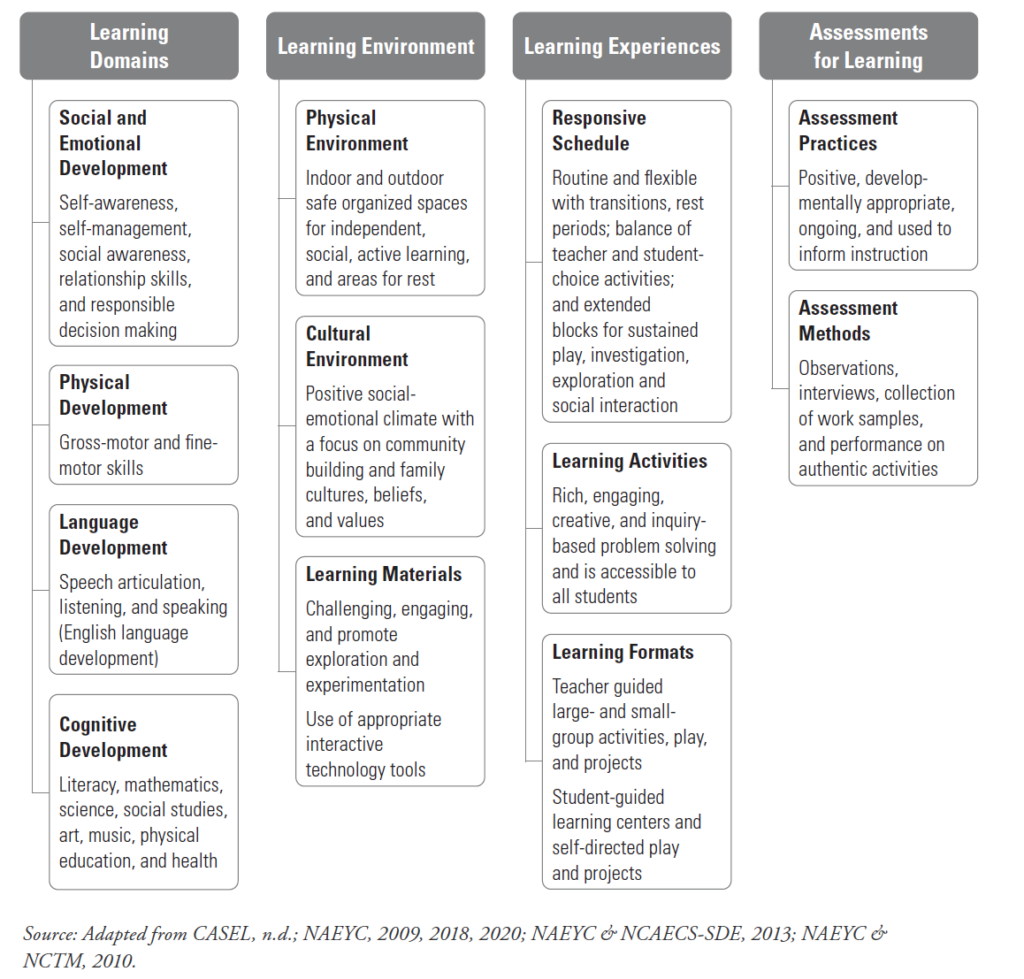
Learning Domains
In a PLC, learning must be the constant and time the variable (DuFour et al., 2016). Although the task of prioritizing learning outcomes will be a necessity this year, ensuring the health and development of the whole child should remain at the forefront of a team’s decision-making process.
If your team is concerned about students’ social-emotional learning (SEL), that is just as valid a focus for your collaborative work this month as having students identify numbers up to 10, or write persuasive paragraphs. Relationship building is at the foundation of our work, and determining how to effectively balance SEL and academic content is going to be both more important and more challenging during this pandemic. Chapter 3 offers tools for identifying essential standards in both SEL and content areas, and chapter 4 shows how to unwrap those standards into student-friendly learning targets and goal cards such as the one below, which can be used in both an in-person or virtual setting to engage, motivate, and give feedback to students.
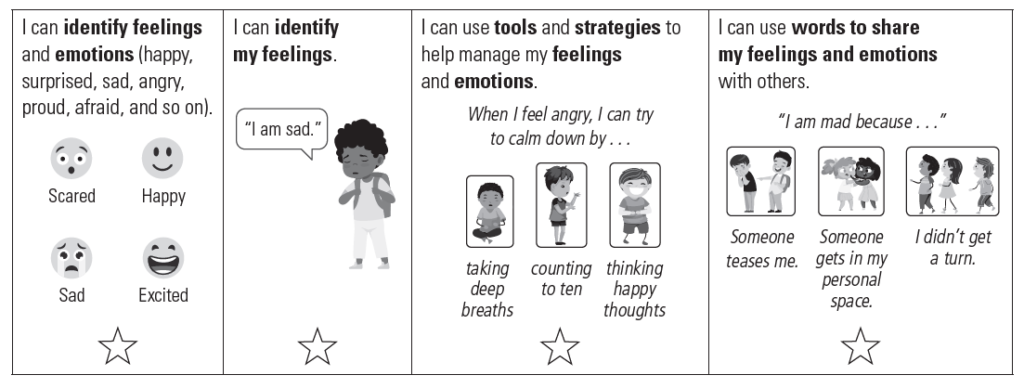
Teams may find using an integrated curriculum approach to learning as the best method for meeting the needs of the whole child’s cognitive, physical, linguistic, and social-emotional development, especially when they have reduced time with students in a virtual setting. Chapter 7 provides guidance and examples for integrating the curriculum both within and across the developmental learning domains.
Learning Environment
Several of the components of a culturally responsive learning environment (Hammond, 2017) are especially important to consider when many districts will likely switch from learning at school to learning in a home environment during this school year, and may even switch several times.
- Create an environment that is intellectually and socially safe for learning.
- Make space for student voice and agency (so students can become leaders of their own learning).
- Use classroom rituals and routines to support a culture of learning.
What is developmentally appropriate for students in the upper grades in a remote learning environment is certainly not the same for a kindergartner. Ask yourselves the following questions when planning:
- Which classroom rituals and routines can transfer to the digital environment to make the space safe and familiar to support learning?
- How can learning tasks be planned to provide maximum student choice and voice in order to improve student engagement and develop agency? (This will be so crucial when students are trying to direct their own learning at home.)
- How do we communicate to parents that they are essential partners in supporting our young students and provide them with tools and strategies to make at-home learning a success?
While we cannot control the home learning environment, we can certainly do our best to impact it. Try such things as teaching parents about flexible seating options for their child (if that’s worked for you in the classroom), or sharing questions parents can use to have comprehension conversations with their children after reading.
Remote learning will be different this year than the crisis learning we got thrown into last spring, so we need to teach both parents and students how to make this sustainable (even while we’re figuring that out ourselves at the same time). That is a heavy task if you were to try to accomplish it alone, but the PLC process means the larger school community, including administrators, specialists, last year’s teachers who know your kids and their families, and all the other adults who support students while in the building continue their collective responsibility to support your students in a virtual learning environment.
Learning Experiences
As important as it is to ensure each child has a device and broadband for distance learning, it is as important that we find ways to get physical materials (books, math manipulatives, play materials, etc.) into the hands of our youngest learners. We also need to continue to model how to interact with those learning materials.
Don’t abandon the low-tech familiar tools that provide meaningful learning experiences in your classroom, even as you embrace new technology. Think of all the learning formats you’ve discovered that engage our young learners and build their communication and cognitive skills, then continue to use them as much as possible even in a remote environment.
For example, record a focus lesson where you sort groups of household items in math and add sticky notes to chart paper to show your steps. Then, have students draw their thinking on inexpensive white boards they hold up to the screen rather than having them respond using the keyboard. Consider the following when planning:
- As we zoom in on the most vital essential learning standards for ALL the learning domains, it will still be important to provide learning experiences that require students to strengthen motor skills and frequently get students up and moving.
- Students’ higher-level thinking skills begin to transform, grow and develop through their experiences with concrete materials during play. The use of virtual images and games alone will not be adequate for a child’s overall learning development. Looking at a three-dimensional shape on a tablet is not the same as physically exploring, touching, or building with three-dimensional blocks.
- When thinking about the schedule, the learning should be chunked into smaller intervals (no more than ten-minute chunks of direct instruction, whether virtual or in person) with the use of planned transitions that purposefully either increase or decrease energy while giving young students time to process what they are learning and avoid mental overload.
- Be sure students practice social-emotional skills both during academic learning and nonacademic times, such as transitional periods or in small-group settings, or a virtual lunch bunch.
In order to ensure students learn in a remote environment, we must focus our collaborative efforts on planning and assessing meaningful learning experiences. Chapter 7 includes lesson-planning structures and designs for connecting, guiding, and applying learning.
Assessment for Learning
We assess what we value. Has what you value for your students changed this year? Will your assessments change? We use assessments to drive our daily instruction and help us know what our students have learned and still need to learn. Often, that looks very different in the early-childhood years; using observations and student interviews until students grow in their cognitive and physical skills when independent response methods become another viable option.
How we gather data during distance learning may require teachers to redefine traditional assessment methods and use observation methods to listen to what students are saying and continuously collect the data over time using anecdotal checklists. Teams may also create learning progressions as a way to establish where students are in their learning, use them to set goals with students, and as an overall method of tracking growth over time.
The SEL goal card shown above was the result of an SEL learning progression created by a team. Chapter 5 has several examples of early-childhood assessment methods and data-collection tools that can be used flexibly for any content area in any environment.
In Rick DuFour’s many keynote speeches over the years, he implored teachers to learn together, and to co-labor. The pandemic has presented us with the opportunity to truly engage in the first order of business for schools that embrace the PLC at Work process: learn together and figure it out.
Being a professional learning community does not mean you will have all the answers, but rather you will begin the process of finding the answers by engaging in collective inquiry, a never-ending journey in which you come back to the table with new information on what worked and what didn’t and learn together again in this cycle of continuous improvement.
We have known for a long time that collaboration over isolation is paramount to delivering high-quality education, so we four co-authors collaborated to ensure What About Us? The PLC at Work Process for Grades PreK-2 Teams will be a useful resource for early-childhood educators dedicated to continuous improvement. With continued collaboration and a focus on equity, ingenuity, and hard work, this challenging time has the potential to help us learn and grow from each other and even provide a platform for enhancing and improving some needed areas of change.
[author_bio id=”1025″]
[author_bio id=”1022″]
[author_bio id=”2988″]


